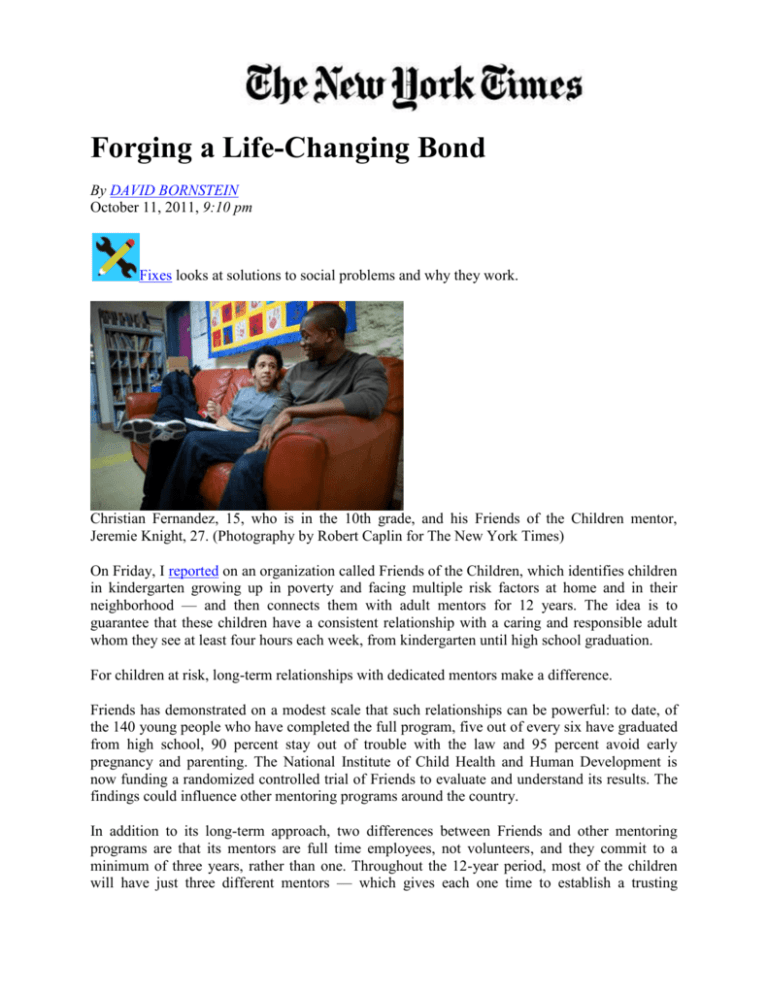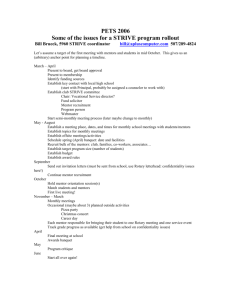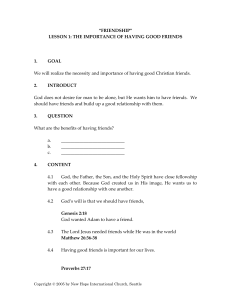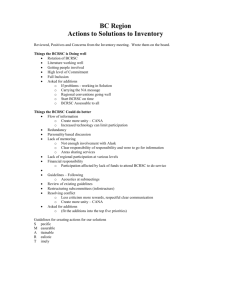Forging a Life-Changing Bond. - Friends of the Children | New York
advertisement

Forging a Life-Changing Bond By DAVID BORNSTEIN October 11, 2011, 9:10 pm Fixes looks at solutions to social problems and why they work. Christian Fernandez, 15, who is in the 10th grade, and his Friends of the Children mentor, Jeremie Knight, 27. (Photography by Robert Caplin for The New York Times) On Friday, I reported on an organization called Friends of the Children, which identifies children in kindergarten growing up in poverty and facing multiple risk factors at home and in their neighborhood — and then connects them with adult mentors for 12 years. The idea is to guarantee that these children have a consistent relationship with a caring and responsible adult whom they see at least four hours each week, from kindergarten until high school graduation. For children at risk, long-term relationships with dedicated mentors make a difference. Friends has demonstrated on a modest scale that such relationships can be powerful: to date, of the 140 young people who have completed the full program, five out of every six have graduated from high school, 90 percent stay out of trouble with the law and 95 percent avoid early pregnancy and parenting. The National Institute of Child Health and Human Development is now funding a randomized controlled trial of Friends to evaluate and understand its results. The findings could influence other mentoring programs around the country. In addition to its long-term approach, two differences between Friends and other mentoring programs are that its mentors are full time employees, not volunteers, and they commit to a minimum of three years, rather than one. Throughout the 12-year period, most of the children will have just three different mentors — which gives each one time to establish a trusting relationship. Because of this approach, the cost per child is higher than volunteer-based programs — currently $9,000 per child per year. I asked readers whether society should bear this cost. They said yes. “If society isn’t willing to pay $9,000 per year for this, then we’re going to continue to pay billions per year to incarcerate millions,” wrote Michael K, from New York (10). “It seems to me that this is the cheap solution.” One of the obstacles, noted Dana, from Milford, Pa. (5) is getting policy makers to think differently. “Unfortunately, this country doesn’t have a great track record of investing in preventative interventions that are clearly shown to reduce the ultimate cost to society,” she wrote. According to data supplied by Friends, during its 10-year history in New York, none of the 120 children it mentored there have dropped out of school. The expected drop out rate for this demographic is higher than 25 percent. During the decade, only two youths have gotten involved with the juvenile justice system and only one has become a teen parent. Based on government data, one would have predicted those figures to be four to six times higher. Everyone knows that it is far more effective and cost-effective to help children develop in a healthy manner than to have to support or rehabilitate them as adults. But how much more costeffective could it be? Mark Chussil, from Oregon (34) helped Friends put a dollar figure to the savings. He co-led a pro bono project through the Community Partners program of the Harvard Business School Association of Oregon which determined that for each child that Friends assisted, society would save $838,030 – roughly $715,000 more than the program costs — largely because the students are more likely to contribute to society than to become dependent on public resources or involved with crime. As an investment, that’s close to a 700 percent return. “The program reaches break-even a very few years after a child graduates,” noted Chussil. “If a for-profit business could show results like that, we’d be lining up to buy stock in it.” (The only intervention I’ve come across that can beat this return is investing in early childhood education, as the economist James Heckman has argued.) The core of Friends is the quality of the bond between the mentors and the children or youth. I visited the Friends house, a lively basement flat on 113th street in Harlem recently and spent time with Christian Fernandez, 15, who is in the 10th grade, and his mentor, Jeremie Knight, 27, a graduate of Florida A&M, who had studied juvenile justice and previously worked in an organization involved in foster care prevention. “I saw that a lot of kids didn’t seem to have anyone in their corner,” Jeremie recalled. “Everybody needs help — everybody.” Jeremie and Christian have been together for four years and it was obvious that they have a warm and genuine relationship. They spoke about trips they’d taken together, including a recent one to a college campus. Jeremie gently ribbed Christian about his left hand dribbling and Christian said he’d been working on it. It was clear he looked up to Jeremie. I asked Christian how Jeremie had influenced him. “He helped me socialize and gave me a lot of help with my education,” he said. In the previous year, Christian added, he’d gotten into a pattern of cutting class, smoking and focusing more on girls than school. Jeremie helped him refocus on his studies. “Without him, I probably wouldn’t be as on top of school as I am now,” he said. I asked him if any specific incidents stood out. While he pondered the question, Jeremie interjected with a smile: “Remember Mr. V.’s class?” That brought a laugh from the two of them — and Christian recalled his sixth grade science class. Sixth grade is a threshold year for many children — it’s the first year of middle school, which brings heavier academic and social pressures, and it’s when many children who fall behind drop out of school emotionally, even if they don’t physically stop showing up until high school. Christian had a conflict with Mr. V., who he thought disliked him. “I never paid attention, I was a jokester,” he recalled. “I just tried to aggravate him for the class to laugh. I was just destructive in that class.” Jeremie sat in on the class a few times and then helped Christian think about how his behavior affected his friends and could damage his future. He helped him understand how to “codeshift” — recognizing that behavior that’s fine with friends is not appropriate in school. Christian listened, settled down, and passed the class. When I asked Jeremie the most important thing he had learned from mentoring, he said: “You’ve got to let the kid be comfortable being who they are. Don’t have a specific idea of what you want the kid to be.” Robert Houck, who directs the Friends office in New York, added that the most important quality for a mentor is the ability to listen. “Many adults don’t know how to listen to youth,” he explained. He noted that some mentors do better with young kids and some connect best with older ones. “Only about 25 percent work equally well with both groups,” he said. Another benefit of establishing a long-term mentoring relationship is that the trust gets extended to the whole family. Jeremie has a good rapport with Christian’s mother, Yvette Pimintel, and together they discuss Christian’s progress in school and his development. “His mentor can take him to places where I would normally not take him because I don’t enjoy it — basketball games, baseball games, museums,” Pimintel told me. “Christian’s had three mentors and he’s loved them all. And they’re always checking up on him, making sure he’s doing what he’s supposed to do, something I can’t do because I’m at work.” Because mentors enjoy the trust of families, they often get more truthful information about home life than public agencies, and they can use their influence to encourage parents to sign up for parenting classes, home safety programs, or services for addiction or domestic violence. In New York, Friends collaborates with 70 organizations which provide families with a wide range of “wraparound” services, everything from crisis intervention to mental health to summer camps. Lindsey K. Robertson, Friends’ Clinical and Education Director in New York, added that it’s critical to find mentors who do not prejudge the families they serve. “If they use phrases like deadbeat dad, hopeless or useless mom, it tells us that their expectations about the situation may limit their effectiveness and creativity. When you have those attitudes, you often give up on people — and you don’t get to see what’s really possible.” Creating a human lifeline is a smarter way to help struggling families than to take the punitive approach. Unfortunately, public policies often get enacted out of moralistic and careless impulses that are politically expedient. That’s the case today, for example, with states forcing people to undergo drug testing in order to receive benefits like welfare, unemployment assistance and food stamps. When people fail the tests, it’s usually because they smoked marijuana. Such punitive measures alienate families from government and intensify the stress on parents who are already overwhelmed — while doing nothing to help them address their problems. This increases the risk that their children will suffer from more dislocations and abuse. Bringing a caring and resourceful adult into a family in crisis can offer new ideas and perspectives, and challenge people to solve their own problems. Jeremie told me that his biggest surprise as a mentor wasn’t seeing transformations among the children – he expected that — but among the parents who subsequently took steps to improve their lives. We all need examples and models to imagine new possibilities, especially if our experience has been severely limited. Houck told me that some of the children served by Friends in New York had never seen Central Park before their mentor took them there. And Robertson recalled the reaction of a young boy who was taken on a visit to the Big Apple Circus: “He said the fountain at Lincoln Center was the most wonderful place he’d ever seen. Then when he entered the circus tent and saw the lights, he literally burst into tears. It was so bright and beautiful, he said. He’d never seen anything like it. He just couldn’t believe it.” Join Fixes on Facebook and follow updates on twitter.com/nytimesfixes. David Bornstein is the author of “How to Change the World,” which has been published in 20 languages, and “The Price of a Dream: The Story of the Grameen Bank,” and is co-author of “Social Entrepreneurship: What Everyone Needs to Know.” He is the founder of dowser.org, a media site that reports on social innovation.







